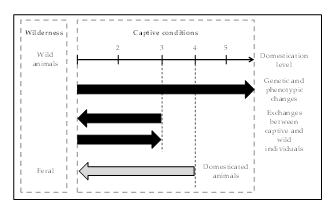FISH DOMESTICATION AND GENETICS: A BRIEF OVERVIEW
During the domestication of fish, the animals will gradually diverge from their wild ancestors, so that they will no longer be considered captive wild animals, or even tame, but domesticated. Nevertheless, it is important to emphasize that the distinction between wild and domesticated remains elusive and one should not consider that wild/domestic represents a dichotomy such as black/white or true/false. On the contrary, there is a continuum between these two extremes, and considering a species as domesticated is somewhat arbitrary and questionable for fishes in which domestication is relatively recent, except for a handful of species .
To get around this problem, we proposed the concept of domestication levels, including five successive levels
(Figure 1).
Evolution of a wild fish species throughout the process of domestication. As soon as wild animals are
transferred to captivity (level 1), the process starts. The numbers correspond to the domestication levels:
initial rearing trials (level 1), control of a portion of the life cycle in captivity (level 2), control of the entire life cycle in captivity (level 3), control of the life cycle without input from the wild (level 4), and implementation of breeding programs (level 5) . During domestication, wild animals will evolve both genetically and phenotypically, particularly when exchanges
with wild congeners do no longer exist (level 4). Domesticated animals can return to the wild and are then known as feral.
Once species have reached level 4, breeding programs (level 5) can be implemented. Historically, these programs have focused on growth enhancement, then feed conversion efficiency, age of sexual maturity, improved resistance to bacterial and viral diseases, and a number of product quality-related traits have been progressively included. The considerable improvement in fish performance has been made possible by the tremendous progress in genetic selection techniques and concepts , which have been applied to an increasing number of species.
In conclusion, d omestication is an ongoing process that adapts fish to both captive conditions and humans. New breeding programs will need to balance market and non-market values (fish welfare) while maintaining sufficient genetic variability to ensure that fish are productive and robust enough to cope with environmental changes. The sustainable future of aquaculture will depend firstly on the continuous improvement of already domesticated fish species and secondly on our willingness and ability to diversify farmed fish species, preferably indigenous ones, to promote a more resilient and balanced aquaculture production at the global level.
